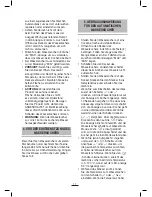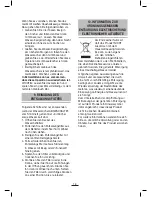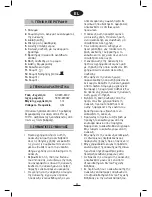
11
10. INFORMATION FOR THE CORRECT
DISPOSAL OF ELECTRICAL AND
ELECTRONIC APPLIANCES
At the end of its working
life, the product must not
be disposed of as urban
waste. It must be taken to
a special local authority
differentiated waste
collection centre or to a
dealer providing this service. Disposing of
a household appliance separately avoids
possible negative consequences for the
environment and health deriving from
inappropriate disposal and enables the
constituent materials to be recovered to
obtain significant savings in energy and
resources.
To remind you that you must collaborate
with a selective collection scheme, the
symbol shown appears on the product
warning you not to dispose of it in
traditional refuse containers.
For further information, contact your local
authority or the shop where you bought the
product.
7. AUTOMATIC SAFETY SHUT-OFF
The kettle is fitted with an automatic safety
protection device in case of overheating
and for when there is no water in the kettle.
It is activated if the kettle is turned on when
there is not enough water inside, i.e. when
the water level is below the MIN mark. If
this happens, switch the kettle off at the
mains and unplug the cable. Leave to cool
for 10 minutes, then refill with cold water
and plug the appliance back in.
8. CLEANING AND MAINTENANCE
After use, unplug the appliance from the
mains and leave to cool.
Clean the base and the outside of the
kettle with a damp (not cloth) and dry
thoroughly with a soft, clean cloth before
storing or plugging back into the mains.
Remove the stubborn marks with a cloth
dampened (not wet) with soap and water or
a gentle, non-abrasive, cleaner.
Do not use chemical products or abrasive
detergents that may scratch the plastic
coating.
Protect the connection base, cable and
plug against humidity.
After repeated use, lime deposits may form
on the inside of the kettle and interfere with
its correct working. These deposits can
be removed using any kettle decalcifying
products available on the market.
If you prefer, you can also decalcify your
kettle with white vinegar. To do so, follow
the instructions outlined below:
•
Place three cups of vinegar in the
kettle and then fill with water. Leave the
water-vinegar mixture to soak overnight
(without boiling).
•
The next morning, pour away the water-
vinegar mixture, fill the kettle with fresh
water and then empty once again.
Repeat this operation. The kettle is now
ready for use.
•
We recommend that you decalcify your
kettle once every 4 weeks if used on a
daily basis.
The following steps can only be taken
when the kettle is SWITCHED OFF,
unplugged from the mains and the kettle
and water are cold.
1. Open the lid of the jug.
2. Extract the anti-scale filter from the jug,
pulling upwards at an angle.
3. Clean the anti-scale filter with a soft
washing-up brush.
4. If necessary, you can leave the anti-
scale filter soaking in vinegar or lemon
juice for a few hours.
5. Rinse the filter thoroughly and dry it
carefully.
6. Install the filter into the jug, aligning it
with the guides in the opening and then
press downwards at an angle. Place
the filter into position by pressing gently
until it is securely in place.
9. CLEANING THE ANTI-SCALE
FILTER













































